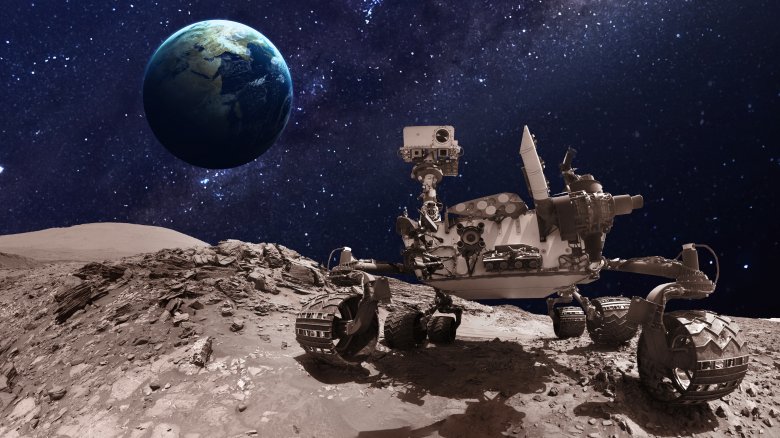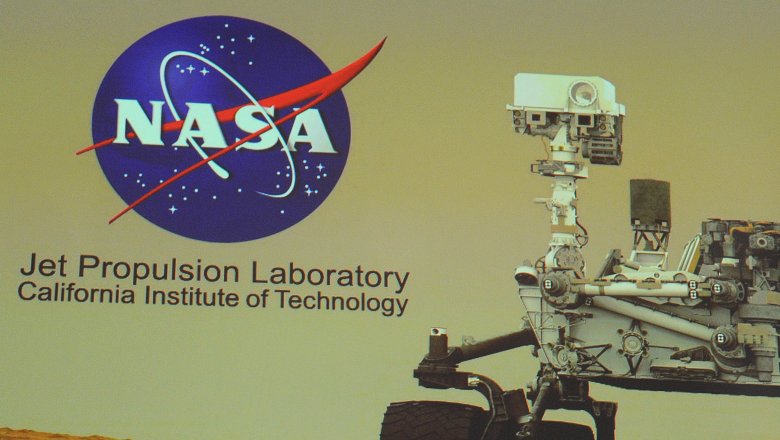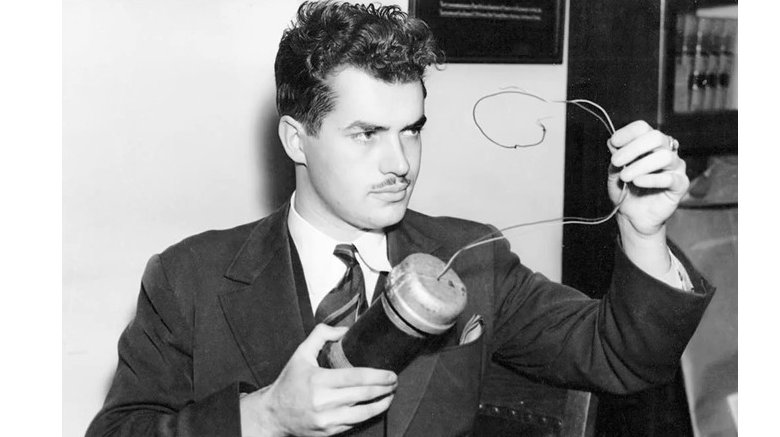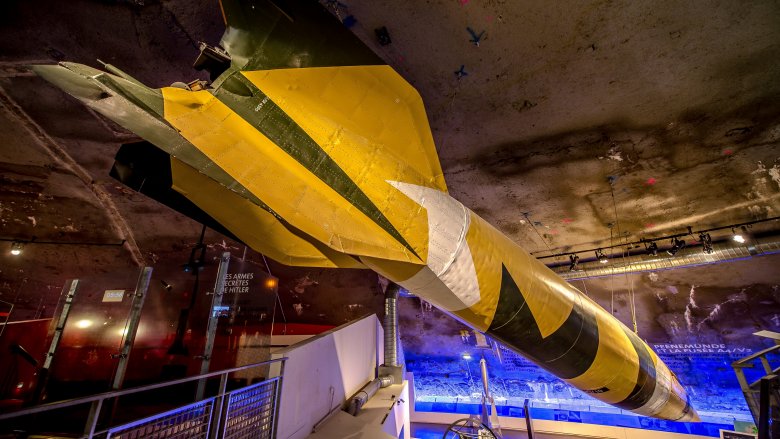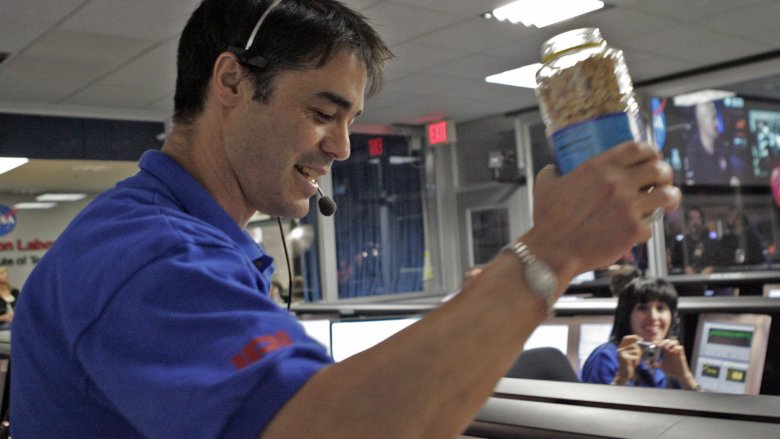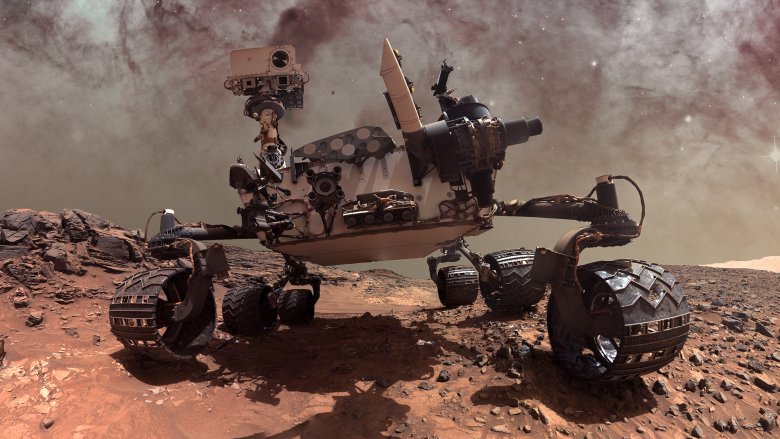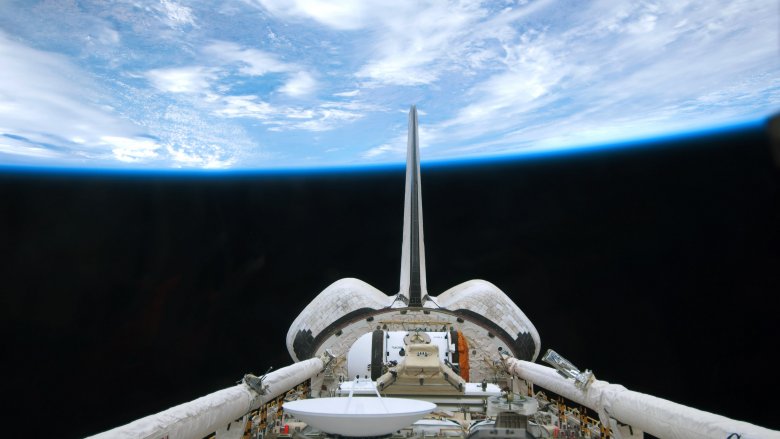The Untold Truth Of The Jet Propulsion Laboratory
We may receive a commission on purchases made from links.
Despite all the chaos, some things make this a pretty neat time to be alive. One of those things is the way we're starting to look at Mars — the prospect of actually settling a new Martian colony is an exciting one. At the center of all this fun stuff is the Jet Propulsion Laboratory, which is also discovering all sorts of cool things about what's flying around us out in space. What is this JPL? What does it actually do? It's a weird story, and it involves the occult, Nazis, and some peanuts.
Who, exactly, are these people?
JPL is usually thought of as synonymous with NASA, but it isn't really. The two organizations are definitely walking hand-in-hand as they stroll through the stars, but not all JPL projects are NASA projects. Popular Mechanics describes the complicated relationship like this: NASA is officially the parent organization, but JPL came first and did all the slogging and groundwork NASA needed to get off the drawing board. That groundwork came in the form of rocketry research JPL did with the U.S. military, and once NASA was created, JPL was moved underneath NASA's umbrella instead of a military one.
NASA funds JPL, but JPL can spend the money how it pleases. It isn't beholden to NASA, but affiliated with Caltech and controlled by a civilian group. Officially, JPL is a "federally funded research and development center," which means it has the benefits of government money with no stranglehold and no one saying an idea is too crazy to try. Which is good, because a lot of JPL's ideas sound really, really crazy.
The Suicide Club
JPL is still a young organization, its first explosions only dating back to the 1930s. According to Business Insider, the original group of Caltech students were actually kicked off campus after one of their earliest rockets — tested in their dorm room — blew up a little bit. Their testing moved to California's San Gabriel mountains, and there wasn't a whole heck of a lot of faith in what they were doing. There was so little faith, in fact, they were nicknamed the Suicide Club. There were several more explosions — including another one on Caltech's campus — but the mishaps of the late 1930s earned them military funding by the early 1940s. By then, they'd set up an actual lab outside Pasadena (seen above in 1942), and honestly, it's no wonder they got the attention of the government. It is, however, a wonder they all lived to tell the tale.
The magical realm of quantum physics
It's no surprise the founding members of JPL were a weird bunch, and the weirdest was probably Jack Parsons. According to Wired, he was largely written out of NASA's official history for a long time, possibly because no one wanted to admit the backbone of NASA's work came from the brain of a man who believed quantum physics could be used to explain magic, and who once worked with L. Ron Hubbard to develop a sex magic ritual that would conjure up a female, elemental girlfriend. Her name would be Babalon (via io9), and she would ultimately give birth to the Antichrist.
There's a lot to unpack there, and it's all true. After JPL secured some serious military backing for its rocket program, Parsons took his share of the cash and converted a mansion for the study of Aleister Crowley's writings and rituals. That's when L. Ron Hubbard moved in, and it seemed like a pretty good fit. (Parsons had long claimed he'd summoned Satan when he was only 13 ... ever the over-achiever.) Even as Parsons climbed through the ranks of Crowley's Ordo Templi Orientis, his neighbors — and employers — were getting more and more annoyed with the orgies, the hallucinogenic trips, and the naked dancing around backyard bonfires. Eventually, things went sideways. Hubbard ran off with the red-headed artist Parsons believed was the elemental he'd summoned, and Parsons himself fell out of favor with the government and JPL, then died in 1952 after dropping some explosives.
A founder's deportation
History is full of singular events that changed the course of entire countries, and the deportation of JPL founder Qian Xuesen was one of those events.
The Chinese-born genius attended both MIT and Caltech, and it was at the latter he fell in with the JPL crowd. He ended up becoming the organization's founding director, worked for them as they developed weapons for the U.S. military through World War II, and was even sent into post-war Europe to find out just what the other side knew.
It seems like his genius was recognized, but he was ultimately arrested, charged with being a Communist, and sent back to China as part of a deal to release 11 American soldiers taken prisoner during the Korean War. Popular Science says there was no evidence he was involved in doing anything wrong, and when he got back to China he didn't give up doing what he loved. He went on to help establish China's space and missile programs, and when he died in 2009 it was after a decades-long career of driving Chinese scientific advancements.
This isn't science fiction
JPL's foundation was in rockets (and explosions), which you'd think would be important enough to make it into the name. It didn't, though, and that's by design.
The organization got the name thanks to two founding members: Caltech aerodynamicist Theodore von Karman and Frank Malina, who was one of his PhD students. The Guardian says they very consciously avoided including the word "rocket" simply because they wanted to be taken seriously. At the time, rockets were associated with science fiction and all kinds of fanciful (but completely implausible) ideas, and that's not what they were doing. They were doing real science.
Malina himself has a pretty fascinating story. He fell under the general FBI label of "premature anti-fascist," and as he was developing the foundation of the country's rocket and space program, he was also speaking out against segregation. He ended up being blacklisted by the government, and as far as he was concerned, they could go blacklist themselves, too. He hated seeing his creations turned nuclear, so he moved to Paris and became an artist. Seriously. And he was a really good one.
JPL's earliest 'computers'
JPL's early work is insanely impressive, and it's even more impressive when you remember computers as we know them today didn't exist yet. Something or someone had to do all those calculations, and it was only when Nathalia Holt stumbled across some old, unlabeled, unidentified archival photographs that the world remembered the someones who did all that insane math.
Holt documented her findings in Rise of the Rocket Girls, and it's a history that started with a core group of women who were among the first JPL employees. She paints a picture that definitely needs an HBO miniseries: a group of women balancing home and family life with decades-long careers, who held math competitions for fun, and who hated the early trend of being called "computresses" because of their gender.
Holt says (via Think Progress) that it started with Macie Roberts, who was one half of a couple working at JPL in the early 1940s. She was made a supervisor, and when it came time to put together an entire team, she decided to only hire women for fear men wouldn't listen to or respect her. The resulting JPL team was rather non-traditional, but they got the job done.
Recruiting the Nazis
Operation Paperclip was the name of the government's program to head into post-war Germany and salvage whatever brilliant minds they could before the Soviets did. Wernher von Braun was one of those scientists, and according to his New York Times obituary, his experiences with rocketry ran alongside JPL's, just for Nazi Germany.
Von Braun started his experimentation with rockets in the 1930s, too, and during World War II he was appointed head of the V-2 mass production program by Hitler himself. (That's a V-2 rocket above.) He resisted the move and ended up in jail for a few weeks, but then the Nazi war machine realized it needed him and he realized he wasn't going to have much of a choice. He eventually surrendered to the Allies in 1945 and was recruited through Operation Paperclip. Once in the States, von Braun ended up partnering with JPL to come up with America's response to Sputnik. That was Explorer, and it resulted in one of the first major, high-profile discoveries of the U.S. space program.
Good luck peanuts
Since 1964, peanuts have been spotted on JPL consoles during the most high-profile events. That's because of a superstition that started with the launch of Ranger 7.
Official JPL history says the first six Ranger missions failed, and if you've failed at anything six times, you know how much the frustration is building by then. Now, imagine the world was watching. When it came time for Ranger 7, everyone was on edge and one member of the team decided to bring in peanuts. Because everyone loves peanuts!
"I thought passing out peanuts might take some of the edge off the anxiety in the mission operations room. The rest is history," said mission trajectory engineer Dick Wallace. It wasn't just history, it was the birth of a tradition. Subsequent Ranger missions were successes, and so were other missions where peanuts were handed out. Oddly, there have been a few times someone's forgotten the peanuts. Those missions have been less successful, which makes you wonder if it's just a superstition. Maybe the space gods like the peanut sacrifices.
JPL has an art studio
When it comes to disciplines, science and art seem like they're on opposite ends of the spectrum. But JPL embraces both, and it actually has a full-fledged art and design studio among its departments. It's a pretty brilliant idea, and The Guardian got a peek at what goes on there. It's the job of JPL's design studio — in part — to make concrete, visual representations of almost unthinkable, unimaginable concepts.
Look at it this way: If you're trying to design something that can land on the surface of a comet, how do you do that without knowing exactly what that surface looks like? That's where the design studio comes in, and since you're wondering, it looks a bit like the surface of a pancake. Go figure.
That's not all. The studio also contracts with everyone from movie companies who need a little help with the latest sci-fi flick to advertising agencies. In 2017 they created a series of crazy-awesome travel posters for 14 alien worlds everyone wants to see now (via the LA Times). Pretty cool, right?
Easter eggs
JPL is in a strange position, as it's funded by NASA but not beholden to it. That means there's a limit as to what NASA can tell JPL to do, and JPL is sort of like the brilliant but rebellious teenager. Just look at what it did with the Mars Curiosity rover.
The rover started exploring the Martian landscape in 2012, and when it was designed, engineers knew they needed to include some holes in the tread so it didn't collect all kinds of dirt and rocks between those figurative toes. JPL wanted the holes to spell out "JPL," but NASA said no.
Then JPL went and did it anyway. The tread still spells out "JPL," just in Morse code — and it's literally all over the surface of Mars now, so don't try to tell JPL what to do.
Earthbound research
JPL is well-known for its work with NASA, but it's also got a lot more terrestrial stuff going on than you probably expect. Sure, JPL is reaching for the stars, but it's not forgetting about Earth completely.
JPL and NASA have been using their satellites to study things like Earth's recent record carbon dioxide spike, and they've even taken some otherworldly technology and adapted it to solve terrestrial problems. For example, Fast Company reported the methane sensors developed for the Mars Curiosity rover were being recalibrated into a detection system for leaks along natural gas pipelines.
Prior to that, JPL has helped map California earthquake zones and helped create a large-scale, long-term picture of climate change and how the coldest, deepest waters of the ocean are reacting to the planet's change in temperature (via Science Daily). JPL is also looking at the planet's super volcanoes and trying to figure out how we can avoid devastating disasters like Krakatoa from happening again — and it will, with one of the biggest threats sitting beneath Yellowstone National Park (via the BBC). Oh yeah, and JPL says these terrestrial volcanoes are a bigger threat than anything that can come from outer space. Sleep tight tonight.
Planets That Are Not Mars
For all its different projects, JPL has a pretty straightforward internal structure. Popular Mechanics says there are only four departments: Astrophysics, Earth Science, Mars, and Planets That Are Not Mars. Seriously.
You know what most of those are, so let's talk Planets That Are Not Mars. When the Popular Mechanics article was published — 2016 — there was one particular non-Martian body at the top of JPL's list. That's Enceladus, which you might not recognize as one of Saturn's moons. It's super-exciting because it has water, so much water that icy geysers spout up for miles. There's Titan, too, which stands out because it actually has an atmosphere. Fanciful stuff? Yes, but not even the sky is the limit at JPL. There are already plans in the works to visit another icy moon, Jupiter's Europa. The Europa Clipper will be outfitted with ice-penetrating radar similar to what we can use to see through the polar ice on our own planet.
There are all kinds of projects and potential projects on JPL's to-do list, but there's one other pretty awesome thing that needs mentioning. JPL engineers and researchers aren't assigned to any particular project, and are free to work on whatever sparks their interest. Turns out, they're pretty brilliant at HR, too.
Fighting cancer
Quick, what's the opposite of the wide expanses of space? If you answered something along the lines of "the microcosm of the human body," you're on the right track when it comes to one of JPL's other endeavors. In 2017, The Daily Beast reported on a partnership between the Dr. Susan Love Research Foundation (which focuses on breast cancer research) and JPL.
It started when cancer researchers ran into a problem, which is basically an inability to see the tiny, tiny details of a human breast duct. It's incredibly important because this is where cancer tends to first take root. The ducts are so tiny they're the next thing to nonexistent, and that's where JPL came in.
Specifically, it was the Office of Planetary Protection, which sounds like something out of a Men in Black movie. Part of OPP's job is protecting equipment against contaminants that could interfere with readings. (If you fly something all the way to Mars and "discover" human DNA that was left on the rover's tire, you're gonna feel pretty dumb.) That means being able to detect biomass on an unimaginably small scale. The two organizations have not only teamed up to find a way to separate human and bacterial DNA from tissue samples, but also to map the breast ducts that can become problematic. The technology will, in theory, make early detection even earlier, and that could save lives.
